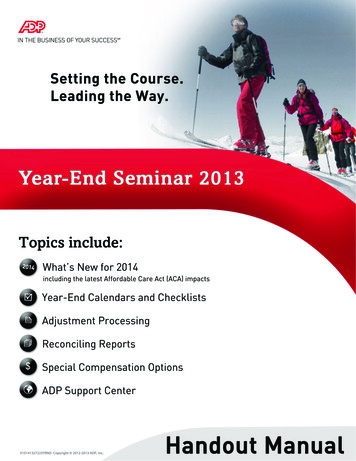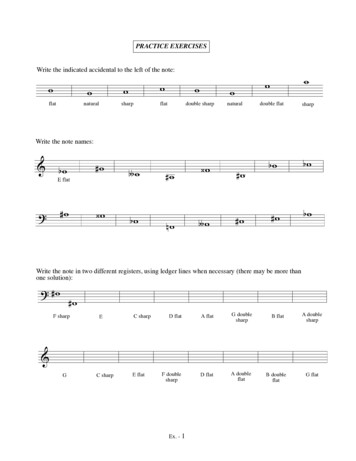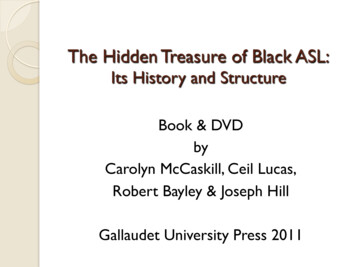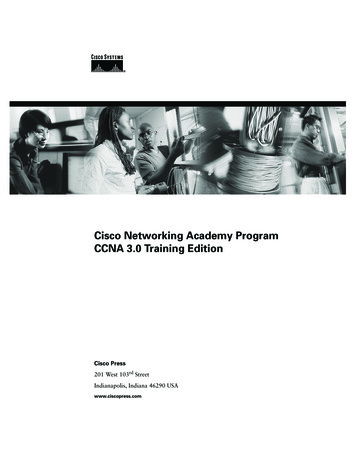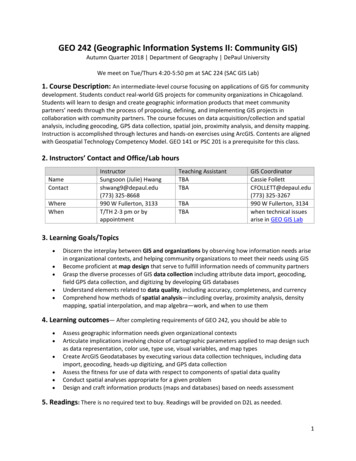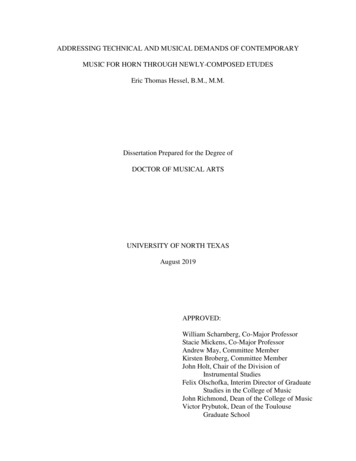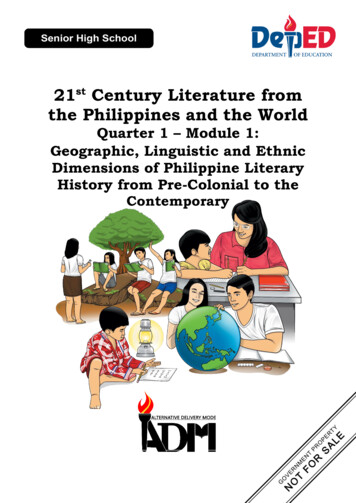
Transcription
21st Century Literature fromthe Philippines and the WorldQuarter 1 – Module 1:Geographic, Linguistic and EthnicDimensions of Philippine LiteraryHistory from Pre-Colonial to theContemporary
21st Century Literature from the Philippines and the WorldAlternative Delivery ModeQuarter 1 – Module 1: Geographic, Linguistic and Ethnic Dimensions of PhilippineLiterary History from Pre-Colonial to the ContemporaryFirst Edition, 2020Republic Act 8293, section 176 states that: No copyright shall subsist in any work of theGovernment of the Philippines. However, prior approval of the government agency or officewherein the work is created shall be necessary for exploitation of such work for profit. Suchagency or office may, among other things, impose as a condition the payment of royalties.Borrowed materials (i.e., songs, stories, poems, pictures, photos, brand names, trademarks,etc.) included in this module are owned by their respective copyright holders. Every efforthas been exerted to locate and seek permission to use these materials from their respectivecopyright owners. The publisher and authors do not represent nor claim ownership overthem.Published by the Department of EducationSecretary: Leonor Magtolis BrionesUndersecretary: Diosdado M. San AntonioDevelopment Team of the ModuleWriters: Allan A. Balud, Noel D. Anciado, and Marites M. AguilarEditors: Alson Rae F. Luna and Paula J. MartinezReviewers: Catherine A. Costoy, Abigail P. Asunto, and Marissa O. AguirreIllustrator: Mary Grace S. Santos and Veronica O. PerojaLayout Artist: Jennifer U. CruzManagement Team: Wilfredo E. CabralJob S. Zape Jr.Eugenio S. AdraoElaine T. BalaoganFe M. Ong-ongowanVioleta L. FranciscoMarissa O. AguirreEdnel A. AlmoradiePrinted in the Philippines byDepartment of Education – Region IV-A CALABARZONOffice Address:Telefax:E-mail Address:Gate 2 Karangalan Village, Barangay San IsidroCainta, Rizal .gov.ph
21st Century Literature fromthe Philippines and the WorldQuarter 1 – Module 1Geographic, Linguistic and EthnicDimensions of Philippine LiteraryHistory from Pre-Colonial to theContemporary
Introductory MessageFor the facilitator:Welcome to the 21st Century Literature 11 Alternative Delivery Mode (ADM) Moduleon Geographic, Linguistic and Ethnic Dimensions of Philippine Literary Historyfrom Pre-Colonial to the Contemporary.This module was collaboratively designed, developed, and reviewed by educatorsboth from public and private institutions to assist you, the teacher, or facilitator inhelping the learners meet the standards set by the K to 12 Curriculum whileovercoming their personal, social, and economic constraints in schooling.This learning resource hopes to engage the learners in guided and independentlearning activities at their own pace and time. Furthermore, this also aims to helplearners acquire the needed 21st-century skills while taking into considerationtheir needs and circumstances.Also, you will see this box in the body of the main text in this module:Notes to the TeacherThis contains helpful tips or strategiesthat will help you in guiding the learners.As a facilitator, you are expected to orient the learners on how to use this module,encourage and assist them as they do the tasks, and track their progress whileallowing them to manage their learnings.For the learner:Welcome to the 21st Century Literature 11 Alternative Delivery Mode (ADM) Moduleon Geographic, Linguistic and Ethnic Dimensions of Philippine Literary Historyfrom Pre-Colonial to the Contemporary.The hands are one of the most symbolized parts of the human body. They are oftenused to depict skill, action, and purpose. Through your hands, you may learn,create, and accomplish. Hence, the hands in this learning resource signify thatyou, as a learner, are capable and empowered to successfully achieve the relevantcompetencies and skills at your own pace and time. Your academic success lies inyour own hands!This module was designed to provide you with fun and meaningful opportunitiesfor guided and independent learning. You will be enabled to process the contents ofthe learning resource while being an active learner.ii
This module has the following parts and corresponding icons:What I Need to KnowThis will give you an idea of the skills orcompetencies you are expected to learn inthe module.What I KnowThis part includes an activity that aims tocheck what you already know about thelesson to take. If you get all the answerscorrect (100%), you may decide to skip thismodule.What’s InThis is a brief drill or review to help you linkthe current lesson with the previous one.What’s NewIn this portion, the new lesson will beintroduced to you in various ways such as astory, a song, a poem, a problem opener, anactivity or a situation.What is ItThis section provides a brief discussion ofthe lesson. This aims to help you discoverand understand new concepts and skills.What’s MoreThis comprises activities for independentpractice to solidify your understanding andskills of the topic. You may check theanswers to the exercises using the AnswerKey at the end of the module.What I Have aph to be filled in toprocess what you learned from the lesson.What I Can DoThis section provides an activity which willhelp you transfer your new knowledge orskill into real life situations or concerns.AssessmentThis is a task which aims to evaluate yourlevel of mastery in achieving the learningcompetency.Additional ActivitiesIn this portion, another activity will be givento you to enrich your knowledge or skill ofthe lesson learned. This also tends retentionof learned concepts.Answer KeyThis contains answers to all activities in themodule.iii
At the end of this module you will also find:ReferencesThis is a list of all sources used indeveloping this module.The following are some reminders in using this module:1. Use the module with care. Do not put unnecessary mark/s on any part ofthe module. Use a separate sheet of paper in answering the exercises.2. Don’t forget to answer What I Know before moving on to the other activitiesincluded in the module.3. Read the instruction carefully before doing each task.4. Observe honesty and integrity in doing the tasks and checking youranswers.5. Finish the task at hand before proceeding to the next.6. Return this module to your teacher/facilitator once you are through with it.If you encounter any difficulty in answering the tasks in this module, do nothesitate to consult your teacher or facilitator. Always bear in mind that you arenot alone.We hope that through this material, you will experience meaningful learningand gain deep understanding of the relevant competencies. You can do it!iv
What I Need to KnowThis module was designed and written with you in mind. It is here to help youunderstand 21st Century Literature from the Philippines and the World. The scopeof this module permits it to be used in many different learning situations. Thelanguage used recognizes the diverse vocabulary level of students. The lessons arearranged to follow the standard sequence of the course. But the order in which youread them can be changed to correspond with the textbook you are now using.The module is divided into two lessons, namely: Lesson 1 – Lesson 2 –Geographic, Linguistic and Ethnic Dimensions ofPhilippine Literary History from Pre-Colonial to theContemporary.Identifying Representative Texts from the RegionsAfter going through this module, you are expected to:1. Identify geographic, linguistic, and ethnic dimensions of Philippine literaryhistory from pre-colonial to contemporary and representative texts from theregions.2. Write a close analysis and critical interpretation of literary texts.3. Show a sense of adaptability of the Philippine Literary HistoryNotes to the TeacherUse the module with care especially in turning each page. Pleasebe reminded to ask the student to answer the Pre-Test beforemoving on to the Lesson Proper. Read and make sure that thestudents understand the directions in every exercise. Encouragethe student to observe honesty in answering the tests andactivities and in checking the answers. Do not put unnecessarymark/s on any part of this module. And answer on a separatesheet of paper.v
What I KnowChoose the letter of the best answer. Write the chosen letter on a separatesheet of paper.1. During this period, Jose Rizal’s works such as Noli Me Tangere and ElFilibusterismo were written to awake the mind of our countrymen.a. Spanish Periodb. American Periodc. Pre-Spanish Periodd. Period of Enlightenment2. The Philippines had literature such as legends, folktakes, folksongs, and thelike.a. Spanish Periodb. Japanese Periodc. Pre-Spanish Periodd. Period of Enlightenment3. In this period, religious books were written, such as Doctrina Cristiana andUrbana and Felisa, to support or contradict the Catholic Church.a. Spanish Periodb. American Periodc. 21st Century Periodd. Period of Enlightenment4. Filipino writers went into all forms of literature like news, reporting, poetry,stories play, essays, and novels which clearly depicted their love of countryand their longings for independence.a. Edsa I Periodb. American Periodc. Pre-Spanish Periodd. The 3rd Republic Period5. Filipino literature was given a break during this period for the Filipinoliterature was prohibited from using. Many wrote plays, poems, shortstories, etc. Topics and themes were often about life in the provinces.a. Japanese Periodb. American Period2
c. Pre-Spanish Periodd. American Period6. Haiku and Tanaga were influenced by what period?a. Spanish Periodb. Japanese Periodc. 21st Century Periodd. Period of Enlightenment7. This period presented new trends in writing using modern technology.a. Edsa I Periodb. 21st Century Periodc. Pre-Spanish Periodd. The 3rd Republic Period8. This literary period witnessed newspapers which were once branded cronynewspapers become instant opposition papers.a. Japanese Periodb. American Periodc. Pre-Spanish Periodd. Edsa I Period9. Poetry during this period were during this period were romantic andrevolutionary.a. The 3rd Republic Periodb. Edsa I Periodc. 21st Century Periodd. Pre-Spanish Period10. Poetry during this period were dealt with patience, regard for native cultureand customs.a. The 3rd Republic Periodb. 21st Century Periodc. Edsa I Periodd. New Society Period11. Philippine regional literature can be BEST described as .a. Dynamicb. Outdatedc. Spokend. Traditional12. Imagery in poetry pertains to .a. Mental picturesb. Unique drawingsc. Vague resemblancesd. Word creations3
13. The use of the vernacular in regional literature isa. discouraged because many people do not understand a piece notwritten in either English or Tagalogb. encouraged so that the culture and tradition of a people are uphelddespite effects of modernityc. opposed for the reason that it constraints the expression of thoughts,feelings, and ideas of a writerd. affirmed by many for it allows free flow of feelings and in-sights notunderstandable to readers14. A valid observation of literary development in the Philippines is that .a. History is recorded only in the oral tradition of the country.b. No literature could reflect the richness of our country's experiences.c. Literary masterpieces are written by great persons with greatremembrances.d. Literature developed alongside Philippine history.15. Because of the archipelagic nature of the Philippines, its geographicalfeatures, and the presence of various ethno-linguistic groups in the country,regional literature has become .a. Anti-modern and traditionalb. Short yet vividc. Rich and variedd. Nationalistic4
Lesson Geographic, Linguistic and Ethnic1Dimensions of Philippine Literary Historyfrom Pre-Colonial to the Contemporary21st Century Literature from the Philippines and the World Module aims toengage students in appreciation and critical study of 21st CenturyLiterature from the Philippines and the World, encompassing their variousdimensions, genres, elements, structures, contexts, and traditions.What’s In1. What do you know about the different Literary Periods in PhilippineLiterature?2. What are the essential elements of the literary pieces underdifferent periods of literature?What’s NewTask 1. Literary TimelineDirections: Try to complete the literary TIMELINE below. Choose youranswers from the given choices written below.15651.1566- 18721871 18982.3.1898- 1941- 1946- 1970- 1981- 1886- 20011841 1945 1970 1980 1885 1999 present4.5.6.57.8.9.10.
a.b.c.d.e.Japanese PeriodRebirth of FreedomPost EDSAAmerican PeriodPre-Spanish Periodf. 21st Centuryg. Spanishh. Period of Enlightenmenti. Period of Activism & New Societyj. Period of Literature in EnglishWhat is ItThink About This!Our forefathers already had their literature, which reflected in theircustoms and traditions. They had their alphabet even before they hadcolonized. The Spanish friars burned their alphabet in the belief thatthey were works of the devil or were written on materials that quicklyperished, like the barks of trees, dried leaves, and bamboo cylinders,which could not have remained firm even if efforts were made to preservethem. Our unique geographic location is the reason why we are rich.PRE-SPANISH LITERATURE - is characterized by: Folk tales. These are made up of stories about life, adventure,love, horror, and humor where one can derive lessons.An example of this is THE MOON AND THE SUN. The Epic Age. Epics are long narrative poems in which a series ofheroic achievements or events, usually of a hero, are dealt withat length. Folk Songs. These are one of the oldest forms of Philippine literature thatemerged in the pre-Spanish period.These songs mirroredthe early forms of culture. Many of these have 12 syllables.Examples of which are Kundiman, Kumintang o Tagumpay,Ang Dalit o Imno, Ang Oyayi o Hele, Diana, Soliraning andTalindaw6
Understanding Literary HistoryLiterature in this period may be classified as religious prose and poetry and secularprose and poetry. Spanish Influences On Philippine LiteratureThe first Filipino alphabet, called ALIBATA, was replaced by the Romanalphabet. Also, the teaching of the Christian Doctrine became the basis ofreligious practices. European legends and traditions brought here becameassimilated in our songs, corridos, and moro-moros. Folk SongsIt manifests the artistic feelings of the Filipinos and shows their innateappreciation for and love of beauty. The examples are Leron-Leron Sinta,Pamulinawen, Dandansoy, Sarong Banggi, and Atin Cu Pung Sing-sing. Recreational PlaysThere were many recreational plays performed by Filipinos during theSpanish times. Almost all of them were in a poetic form such Cenaculo,Panunuluyan, Salubong and Zarzuela.PERIOD OF ENLIGHTENMENT (1972- 1898)In 19th Century, Filipino intellectuals educated in Europe called Ilustrados beganto write about the hitch of colonization.The Propaganda Movement (1872-1896) - This movement was spearheadedmostly by the intellectual middle-class like Jose Rizal, Marcelo delPilar; Graciano Lopez Jaena, Antonio Luna, Mariano Ponce, Jose Ma.Panganiban, and Pedro Paterno.oSome of Rizal’s writings: Noli Me Tangere, Mi Ultimo Adios,Sobre La Indolencia Delos Filipinos and Filipinas Dentro DeCien Aňos.oSome of Del Pilar’s writings: Pagibig sa Tinubuang Lupa (Love ofCountry), Kaingat Kayo (Be Careful), and Dasalan at Tocsohan(Prayers and Jokes).oSome of Jaena’s writings: Ang Fray Botod, La Hija Del Fraile(The Child of the Friar), and Everything Is Hambug(Everything is mere show), Sa Mga Pilipino.1891),andTalumpating Pagunita Kay Kolumbus (An Oration toCommemorate Columbus).7
THE AMERICAN REGIME (1898-1944)Linguistically, Americans influenced Filipino writers to write using Englishlanguage. Jose Garcia Villa became famous for his free verse.Characteristics of Literature during this period:The languages used in writing were Spanish and Tagalog and the dialects ofthe different regions. But the writers in Tagalog, continued in theirlamentations on the conditions of the country and their attempts to arouselove for one’s native tongue and the writers in English imitated the themesand methods of the Americans.THE JAPANESE PERIOD (1941-1945)Philippine Literature was interrupted in its development when another foreigncountry, Japan, conquered the Philippines between1941-1945. Philippine literaturein English came to a halt. This led to all newspapers not to be circulated in thecommunity except for TRIBUNE and PHILIPPINE REVIEW.o Filipino Poetry during this periodThe common theme of most poems during the Japaneseoccupation was nationalism, country, love, and life in the barrios,faith, religion, and the arts.oThree types of poems emerged during this period:a. Haiku , a poem of free verse that the Japanese like. It wasmade up of 17 syllables divided into three lines andb. Tanaga – like the Haiku, is short, but it had measure andrhyme.c. Karaniwang Anyo (Usual Form)PHILIPPINE LITERATURE IN ENGLISH (1941-1945)Because of the strict prohibitions imposed by the Japanese in the writing andpublishing of works in English, Philippine literature in English experienced a darkperiod. For the first twenty years, many books were published both in Filipino andin English.In the New Filipino Literature, Philippine literature in Tagalog was revived duringthis period. Most themes in the writings dealt with Japanese brutalities, thepoverty of life under the Japanese government, and the brave guerilla exploits.8
PERIOD OF ACTIVISM (1970-1972)According to Pociano Pineda, youth activism in 1970-72 was due to domestic andworldwide causes. Because of the ills of society, the youth moved to seek reforms.The Literary RevolutionThe youth became vocal with their sentiments. They demanded achange in the government. It was manifested in the bloodydemonstrations and the sidewalk expressions and also in literature.PERIOD OF THE NEW SOCIETY (1972- 1980)The period of the New Society started on September 21, 1972. The Carlos PalancaAwards continued to give annual awards. Poems dealt with patience, regard fornative culture, customs, and the beauties of nature and surroundings. Newspapersdonned new forms.News on economic progress, discipline, culture, tourism, and the like were favoredmore than the sensationalized reporting of killings, rape, and robberies. Filipinosbefore were hooked in reading magazines and comics.PERIOD OF THE THIRD REPUBLIC (1981-1985)After ten years of military rule and some changes in the life of the Filipino, whichstarted under the New Society, Martial Rule was at last lifted on January 2, 1981.The Philippines became a new nation, and this, former President Marcos called“The New Republic of the Philippines.” Poems during this period of the ThirdRepublic were romantic and revolutionary. Many Filipino songs dealt with themesthat were true-to-life like those of grief, poverty, aspirations for freedom, love ofGod, of country and fellowmen.POST-EDSA 1 REVOLUTION (1986-1995)History took another twist. Once more, the Filipino people regained theirindependence, which they lost twenty years ago. In four days from February 21-25,1986, the so-called People Power (Lakas ng Bayan) prevailed. In the short span ofthe existence of the real Republic of the Philippines, several changes alreadybecame evident. It was noticed in the new Filipino songs, newspapers, speeches,and even in the television programs. The now crony newspapers that enjoyed anovernight increase in circulation were THE INQUIRER, MALAYA, and the PEOPLE’SJOURNAL.9
21st CENTURY PERIODThe new trends have been used and introduced to meet the needs and tastes of thenew generation. 21st Century learners are demanded to be ICT inclined to competewith the style and format of writing as well. New codes or lingos are used to addflavor in the literary pieces produced nowadays.What’s MoreActivity 1. Who’s Who?Direction: Identify the author of the following literary pieces written by theIlustrados. Write the letter of your correct answer.A. Jose RizalB. Marcelo H. Del Pilar1. Sa Mga Pilipino2. Mi Ultimo Adios3. Filipinas Dentro De Cien Aňos4. Pag-Ibig sa Tinubuang Lupa5. La Hija del FraileC. Graciano Lopez Jaena6. El Filibusterismo7. Kaingat Kayo8. Ang Fray Botod9. Sobre La Indolencia Delos Filipinos10. Dasalan at Tocsohan10
Assessment 1. Characterize Me!Directions: Complete the table below by writing the characteristics of thefollowing literature during the Pre-Spanish PeriodLegendsFolk TalesThe EpicAgeFolk SongsActivity 2. Thinker’s ViewDirections: Given below is a sample of a Filipino Folktale in the Pre-SpanishPeriod. Answer the questions that follow.THE SUN AND THE MOON(Tingguian folk tale)In the olden days, like the moon, the sun had also star children which wereyellowish in color, very bright and very hot.The star children of the moon, however, were reddish and cool. Thatmoon was scared that his stars would wither and die if they play with thestar children of the sun.The moon suggested to the sun that they kill their children who werecrowding the heavens with their number.When the sun had killed her children, the moon merely hid behind theclouds.In the evening, when the clouds faded, the moon stars appeared.This angered the sun so he gave chase to the moon. Thus, when heovertakes the moon, we have the so-called eclipse.Every morning, the sun kills the moon stars that he catches.Until now, this chase continues and because the moon still continues 1. What is the concern of the moon regarding his stars?2. Why does the moon anger the sun?3. What particular phenomenon is described in the Filipino Folktale?11
Assessment 2. Closer LookDirections: Write three words that will highlight the message of the excerptfrom one of the most famous literary pieces during Spanish time,Pasyon.1.2.3.KASAYSAYAN NG PASYONG MAHAL NI HESUKRISTONGPANGINOON NATIN(COPYRIGHT 1949 BY IGNACIO LUNA & SONS)Panalangin sa Diyos Oh Diyossa kalangitan Hari ng sangkalupaanDiyos na walang kapantay,mabait lubhang maalamat puno ng karunungan.Ikaw ang Amang tibobosng nangungulilang lubosamang di matapus-tapos,maawi't mapagkupkop sa taong lupa't alabok. Iyong itulot sa aminDiyos Amang maawain mangyaring aming dalitin.Assessment 3. Saying a SongDirections: One of the songs in the Post-EDSA I era is the song Ang Bayan Ko.Analyze and interpret the emotions of Filipinos and situations of thecountry found in each paragraph of the song.Ang Bayan KoI.II.II. AtAsa kanyang yumi at gandang bayan kong PilipinasDayuhan ay nahalinaLupain ng ginto't bulaklakBayan ko, binihag kaPag-ibig na sa kanyang paladNasadlak sa dusaNag-alay ng ganda't dilagCHORUSIbon mang may layang lumipad kulungin mo atumiiyak bayan pa kayang sakdal-dilagang 'di magnasang makaalpas,Pilipinas kong minumutya pugad ng luha at dalitaaking adhika makita kang sakdal laya12
What I Have Learned1. Pre-Spanish Literature is characterized by Legends, Folk Tales, The EpicAge, and Folk Songs.2. The Propaganda Movement (1872-1896) was spearheaded mostly by theintellectual middle-class like Jose Rizal, Marcelo del Pilar, Graciano LopezJaena, Antonio Luna, Mariano Ponce, Jose Ma. Panganiban and PedroPaterno.3. In the American Regime, Americans influenced Filipino writers to write usingthe English language. English as a medium of instruction was introduced inthe schools as the intellectual language of education.4. In the Period of Activism, campus newspapers were written to show theirprotest. They held pens and wrote on placards in red paint the equivalent ofthe word MAKIBAKA (To dare!).5. Period of the New Society poems dealt with patience, regard for nativeculture, customs, and the beauties of nature and surroundings.6. The period of the Third Republic was romantic and revolutionary.7. Post EDSA I noticed in the new Filipino songs, in the newspapers, in thespeeches, and even in the television programs.What I Can DoTask 1. As a grade 11 Filipino learner, in what way you can show a sense ofadaptability to the diverse Philippines Literary History? State youranswer in a 3 -5 paragraph essay.15
Lesson Identifying Representative Texts2from the RegionsThe country’s rich repertoire of literary masterpieces may be rooted in the diversecultural heritage of the Filipino people. They have produced varied texts because ofdifferences. The mighty roar of the North and the fiery temperament of the Southblended well. The Filipinos speak of the collective experiences from the people whohave gone through difficulties, triumphs, struggles, successes, armed conflicts,bloodless revolutions, and others. It is the reason why these masterpiecesresonated loud and clear in the Philippine archipelago.What’s In1. What are the different Literary Periods in Philippine Literature?2. What are the basic elements of the literary pieces under the JapaneseRegime? American Period? Spanish Period?3. What are changes in Literature during the 21st Century?What’s NewImagery is a poetic element that tries to create a picture in the mind of thereader or a mental image through the use of figural language. It representsobjects, places, ideas, or even actions that appeal to the senses of thereaders.16
Gabuby Carlos A. AngelesThe battering restlessness of the seaInsists a tidal fury upon the beachAt Gabu, and its pure consistencyHavos the wasteland hard within itsreach.Brutal the daylong bashing of its heartAgainst the seascape where, for milesaround,Farther than sight itself, the rockstones partAnd drop into the elemental wound.The waste of centuries is grey and deadAnd neutral where the sea hasbeached its brine,Where the spilt salt of its heart liesspreadAmong the dark habiliments of Time.The vital splendor misses. For here,hereAt Gabu where the ageless tide recursAll things forfeited are most loved anddear.It is the sea pursues a habit of shores.1. What image does the poem, Gabu, try to create?2. Which word or group of words from the poem help you form thisimage? Draw this on a separate sheet of paper.What is ItA Taste of Philippine PoetryLocated in the northwest of Luzon, the Ilocos Region or Region 1 is comprised offour provinces, namely: Ilocos Norte, Ilocos Sur, La Union, and Pangasinan. It isbordered to the west by the turbulent South China Sea, to the east by theCordillera Administrative Region, the northeast and southeast by Cagayan Valleyand the South by Central Luzon. Most of the inhabitants of the Ilocano homelandare concentrated along a narrow coastal plain. Because of geographical boundaries,these people often experience heavy rains and violent typhoons, especially duringrainy seasons.17
The region, then, takes pride in long stretches of white sand and clear watersalongside its rich cultural heritage. What you are about to read is a poem writtenby a Carlos Palanca Memorial Awardee in Poetry in 1964, Carlos A. Angeles. Hiscollection of poems entitled, Stun of Jewels, also bagged him the Republic CulturalHeritage Award in Literature in the same year.A Moment of SilenceGabu depicts a coastline in Ilocos that is constantly experiencing the batteringrestlessness of the sea. The water that comes back to the shore seems furious andruthless with its daylong bashing, which havocs the wasteland. Being anarchipelagic country, the Philippines knows the importance of water and the sea.A Taste of Tagalog EssayMore popularly known now as the CALABARZON referring to the provinces ofCavite, Laguna, Batangas, Rizal, and Quezon, Region IV-A is home to Tagalogspeaking people in the Philippines. Recognized all over the country for theirbravery and fearlessness in battles, CALABARZON has participated actively in thecountry’s fight for freedom and democracy. It is home to many Philippine heroesforemost, and among them are Rizal of Laguna, Mabini of Batangas, and Aguinaldoof Cavite.A Taste of Creative NonfictionThe island of Visayas is one of the major geographical divisions in the Philippines,the other two being Luzon and Mindanao. It is divided into Western, Central, andEastern Visayas. The Visayas region is comprised of several islands circling theVisayan Sea. Its people, therefore, share a sea-based culture and tradition that maybe rooted in a strong religious foundation.The dwelling place of many festivals such as the Ati-Atihan, Di-nagyang, Sinulog,Pintados, and Maskara, the Visayas may indeed be considered as one of the cradlesof Philippine civilization.18
What’s MoreActivity 1. Graphic OrganizerDirections: Delve deeper into the poem Gabu by Carlos A. Angeles using thegraphic organizer. You may re-read the poem to get the details thatwould complete the organizer.Title of the Text:Author:QUESTIONSRESPONSETOPICWhat is the text all about?SITUATIONWhat is the setting referred to ordescribed in the text?CLIENTWho is the target group of readersof the text?How would you describe the groupin terms of skills, values, beliefsand attitudes?PURPOSEWhy was the text written?What does it hope to achieveespecially among its client?PERSONAWho is the voice behind the text?What is known about him or her?19
Assessment 1. Reflect On MeDirection: Read and answer the questions.Aug 2009 by SIGLIWASalubungin ang (Bagong) Daluyong ng mga Agos sa DisyertoSA PANAHONG tila natutuyuan ang mga linang ng panitikan noong gitnangbahagi ng dekada ’60, dumaloy ang mga akda nina Efren R. Abueg,Dominador B. Mirasol, Rogelio L. Ordo-ñez, Edgardo M. Reyes at Rogelio R.Sikat, sa aklat katipunang Mga Agos sa Disyerto.Unang buhos ng daluyong ay noong 1964 at isang dekada ang lumipas,muling umalon at binasa ang namimitak na lupain ng panitikang Filipino nangmailimbag ang ikalawang edisyon ng Mga Agos sa Disyerto noong 1974.Huling sargo ng daluyong ng Agos ay 16 na taon ang nakararaan, nanglumabas ang ikat-long edisyon nito noong 1993.Ngayon, sa panahong sampu isang pera ang patakbuhing literaturangpatuloy na lumuluoy sa diwa at kaluluwa ng mga Pilipino, m
21st Century Literature from the Philippines and the World Alternative Delivery Mode Quarter 1 – Module 1: Geographic, Linguistic and Ethnic Dimensions of Philippine Literary History from Pre-Colonial to the Contemporary First Edition, 2020 Republic Act 8293, section 176 states that: No copyright shall


